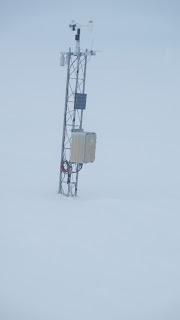View of Mt Discovery from the helo
Our last working day here at McMurdo was February 7th. We made an attempt to fly to Lettau on a Twin Otter, but the weather was not good and we got canceled. Considering we had to finalize all of our back cargo and put everything else in the storage, it was somewhat good news for us. It is sad we did not get as many stations done as we hoped, but some things are just beyond our control. We spent all day running around McMurdo in cold and windy conditions, moving boxes and organizing our shipments, but we managed to pack everything on time!
At the end of the day I even went onboard Russian icebreaker docked in McMurdo for the day. I acted as a translator for a couple of my friends who wanted to come look at the ship with me - we got a small private tour of the vessel and a grapefruit (!!!!!). It was a lot of fun to learn about their work (and to speak Russian again!). And to understand our excitement about a grapefruit you have to spend two months eating only canned food. ;)
At the end of the day I even went onboard Russian icebreaker docked in McMurdo for the day. I acted as a translator for a couple of my friends who wanted to come look at the ship with me - we got a small private tour of the vessel and a grapefruit (!!!!!). It was a lot of fun to learn about their work (and to speak Russian again!). And to understand our excitement about a grapefruit you have to spend two months eating only canned food. ;)
***
The getting off the ice saga begins now. As I mentioned numerous times, there is a backlog of passengers trying to go back North. Lee and I were scheduled to leave today (February 8) at 6am. We checked in our luggage the night before and are now left with one carry-on item each. We did not make it to the flight - they had to cut 9 people off, and Lee and I were among the people cut. As I was anticipating this, I packed spare clothes and other essentials in my carry-on. I called my parents today to share the news of not getting off the ice, and they commented that our reality is very different right now. I wonder how big of a culture shock I will get coming back to "main" land with children, animals, sunsets, trees and fresh vegetables to eat ;)
I originally had a ticket leaving Christchurch on the 9th of February, so I had to deal with changing my ticket and other plans all morning. Luckily, since the delay is totally out of my reach, I was not charged $350 for the ticket change. I was expecting this charge, so it came as a pleasant surprise!
Lee and I are both attending the AMOS annual meeting in Melbourne next week and we both have talks on Monday. So I also wrote to conference organizers to let them know about our rescheduled flight and possible delays getting off the ice. We have another chance to leave tomorrow (Saturday, February 9) and catch a flight from Christchurch to Melbourne on Sunday - but this would be our last chance to get to Melbourne in time to give our talks.
I think of all traits that I learned during this field season, the most important one is learning to accept things I can not change!

















